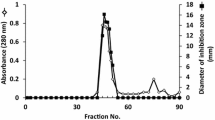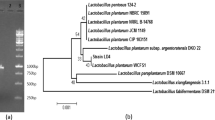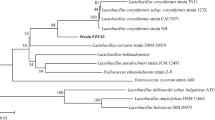Abstract
A novel bacteriocin produced by Lactobacillus plantarum DL3 isolated from Suan-Tsai, a traditional Chinese fermented cabbage, was designated as plantaricin DL3. It was purified by ethyl acetate extraction followed by gel filtration and high-performance liquid chromatography. The molecular weight of plantaricin DL3 was determined as 2149 Da by matrix-assisted laser desorption/ionization time-of-flight mass spectrometry (MALDI-TOF–MS) analysis. The amino acid sequence of plantaricin DL3 was predicted to be VGPGAINAGTYLVSRELFER by MALDI-TOF–MS/MS. This bacteriocin exhibited broad-spectrum antibacterial activity against Gram-positive and Gram-negative bacteria, especially Pseudomonas aeruginosa, high thermal stability (15 min, 121 °C) and narrow pH stability (pH 2.5–5.5). The mechanism of action of this bacteriocin was responsible for the disruption of cell wall, accompanied with the leakage of proteins. These results suggested that plantaricin DL3 has potential applications in the control of Pseudomonas spp. in aquatic products.



Similar content being viewed by others
References
Gram L, Dalgaard P (2002) Fish spoilage bacteria—problems and solutions. Curr Opin Biotechnol 13(3):262–266
Liu H, Zhang L, Yi H, Han X, Chi C (2016) Identification and characterization of plantaricin Q7, a novel plantaricin produced by Lactobacillus plantarum Q7. LWT Food Sci Technol 71:386–390
Al-Haddad KSH, Al-Qassemi RAS, Robinson RK (2005) The use of gaseous ozone and gas packaging to control populations of Salmonella infantis and Pseudomonas aeruginosa on the skin of chicken portions. Food Control 16(5):405–410
Lu H, Shao X, Cao J, Ou C, Pan D (2016) Antimicrobial activity of eucalyptus essential oil against Pseudomonas in vitro and potential application in refrigerated storage of pork meat. Int J Food Sci Technol 51(4):994–1001
Ghanbari M, Jami M, Domig KJ, Kneifel W (2013) Seafood biopreservation by lactic acid bacteria—a review. LWT Food Sci Technol 54(2):315–324
Wan Norhana MN, Poole SE, Deeth HC, Dykes GA (2010) The effects of temperature, chlorine and acids on the survival of Listeria and Salmonella strains associated with uncooked shrimp carapace and cooked shrimp flesh. Food Microbiol 27(2):250–256
Matamoros S, Pilet MF, Gigout F, Prévost H, Leroi F (2009) Selection and evaluation of seafood-borne psychrotrophic lactic acid bacteria as inhibitors of pathogenic and spoilage bacteria. Food Microbiol 26(6):638–644
Todorov SD, Holzapfel W, Nero LA (2015) Characterization of a novel bacteriocin produced by Lactobacillus plantarum ST8SH and some aspects of its mode of action. Ann Microbiol 66(3):949–962
Zhao R, Duan G, Yang T, Niu S, Wang Y (2015) Purification, characterization and antibacterial mechanism of bacteriocin from Lactobacillus Acidophilus XH1. Trop J Pharm Res 14(6):989
Liu G, Song Z, Yang X, Gao Y, Wang C, Sun B (2016) Antibacterial mechanism of bifidocin A, a novel broad-spectrum bacteriocin produced by Bifidobacterium animalis BB04. Food Control 62:309–316
Bali V, Panesar PS, Bera MB, Kennedy JF (2014) Bacteriocins: recent trends and potential applications. Crit Rev Food Sci 56(5):817–834
Zhao S, Han J, Bie X, Lu Z, Zhang C, Lv F (2016) Purification and characterization of plantaricin JLA-9: a novel bacteriocin against Bacillus spp. produced by Lactobacillus plantarum JLA-9 from Suan-Tsai, a traditional Chinese fermented cabbage. J Agric Food Chem 64(13):2754–2764
Hu M, Zhao H, Zhang C, Yu J, Lu Z (2013) Purification and characterization of plantaricin 163, a novel bacteriocinp produced by Lactobacillus plantarum 163 isolated from traditional Chinese fermented vegetables. J Agric Food Chem 61(47):11676–11682
Fang Z, Zhao HF, Bai FL, Dziugan P, Liu Y, Zhang BL (2014) Purification and characterisation of the bacteriocin produced by Lactobacillus plantarum, isolated from Chinese pickle. Czech J Food Sci 32(5):430–436
Song DF, Zhu MY, Gu Q (2014) Purification and characterization of Plantaricin ZJ5, a new bacteriocin produced by Lactobacillus plantarum ZJ5. PLoS One 9(8):e105549
Ström K, Sjögren J, Broberg A, Schnürer J (2002) Lactobacillus plantarum MiLAB 393 produces the antifungal cyclic dipeptides cyclo(L-Phe-L-Pro) and cyclo(L-Phe-trans-4-OH-L-Pro) and 3-phenyllactic acid. Appl Environ Microb 68(9):4322–4327
Chahad OB, El Bour M, Calo-Mata P, Boudabous A, Barros-Velazquez J (2012) Discovery of novel biopreservation agents with inhibitory effects on growth of food-borne pathogens and their application to seafood products. Res Microbiol 163(1):44–54
Liu G, Ren L, Song Z, Wang C, Sun B (2015) Purification and characteristics of bifidocin A, a novel bacteriocin produced by Bifidobacterium animals BB04 from centenarians’ intestine. Food Control 50:889–895
Bradford MM (1976) A rapid and sensitive method for the quantitation of microgram quantities of protein utilizing the principle of protein-dye binding. Anal Biochem 72(1–2):248–254
Schägger H, Jagow GV (1987) Tricine-sodium dodecyl sulfate-polyacrylamide gel electrophoresis for the separation of proteins in the range from 1 to 100 kDa. Anal Biochem 166(2):368
Kumarathasan P, Mohottalage S, Goegan P, Vincent R (2005) An optimized protein in-gel digest method for reliable proteome characterization by MALDI-TOF-MS analysis. Anal Biochem 346(1):85–89
Zhu X, Zhao Y, Sun Y, Gu Q (2014) Purification and characterisation of plantaricin ZJ008, a novel bacteriocin against Staphylococcus spp. from Lactobacillus plantarum ZJ008. Food Chem 165:216–223
Wen LS, Philip K, Ajam N (2016) Purification, characterization and mode of action of plantaricin K25 produced by Lactobacillus plantarum. Food Control 60:430–439
Chen YS, Wang YC, Chow YS, Yanagida F, Liao CC, Chiu CM (2014) Purification and characterization of plantaricin Y, a novel bacteriocin produced by Lactobacillus plantarum 510. Arch Microbiol 196(3):193
Atrih A, Rekhif N, Moir AJG, Lebrihi A, Lefebvre G (2001) Mode of action, purification and amino acid sequence of plantaricin C19, an anti-Listeria bacteriocin produced by Lactobacillus plantarum C19. Int J Food Microbiol 68(1–2):93–104
Todorov SD, Dicks LMT (2005) Effect of growth medium on bacteriocin production by Lactobacillus plantarum ST194BZ, a strain isolated from Boza. Food Technol Biotech 43(2):165–173
Sommerer N, Centeno D, Rossignol M (2007) Peptide mass fingerprinting: identification of proteins by MALDI-TOF. Methods Mol Biol 355(355):219–234
Gong HS, Meng XC, Wang H (2010) Plantaricin MG active against Gram-negative bacteria produced by Lactobacillus plantarum KLDS1.0391 isolated from “Jiaoke”, a traditional fermented cream from China. Food Control 21(1):89–96
Powell JE, Witthuhn RC, Todorov SD, Lmt D (2007) Characterization of bacteriocin ST8KF produced by a kefir isolate Lactobacillus plantarum ST8KF. Int Dairy J 17(3):190–198
Holo H, Jeknic Z, Daeschel M, Stevanovic S, Nes IF (2001) Plantaricin W from Lactobacillus plantarum belongs to a new family of two-peptide lantibiotics. Microbiol 147(3):643–651
Castro MP, Palavecino NZ, Herman C, Garro OA, Campos CA (2011) Lactic acid bacteria isolated from artisanal dry sausages: characterization of antibacterial compounds and study of the factors affecting bacteriocin production. Meat Sci 87(4):321–329
Magnusson J, Schnurer J (2001) Lactobacillus coryniformis subsp. coryniformis strain Si3 produces a broad-spectrum proteinaceous antifungal compound. Appl Environ Microbiol 67(1):1–5
Campos CA, Rodríguez Ó, Calo-Mata P, Prado M, Barros-Velázquez J (2006) Preliminary characterization of bacteriocins from Lactococcus lactis, Enterococcus faecium and Enterococcus mundtii strains isolated from turbot (Psetta maxima). Food Res Int 39(3):356–364
Bajpai VK, Sharma A, Baek K-H (2013) Antibacterial mode of action of Cudrania tricuspidata fruit essential oil, affecting membrane permeability and surface characteristics of food-borne pathogens. Food Control 32(2):582–590
Yi L, Dang J, Zhang L, Wu Y, Liu B, Lü X (2016) Purification, characterization and bactericidal mechanism of a broad spectrum bacteriocin with antimicrobial activity against multidrug-resistant strains produced by Lactobacillus coryniformis XN8. Food Control 67:53–62
Yoneyama F, Imura Y, Ohno K, Zendo T, Nakayama J, Matsuzaki K, Sonomoto K (2009) Peptide-Lipid Huge Toroidal Pore, a new antimicrobial mechanism mediated by a Lactococcal Bacteriocin, Lacticin Q. Antimicrob Agents Chemother 53(8):3211–3217
Li Y-Q, Han Q, Feng J-L, Tian W-L, Mo H-Z (2014) Antibacterial characteristics and mechanisms of ɛ-poly-lysine against Escherichia coli and Staphylococcus aureus. Food Control 43:22–27
Zhao L, Zhang H, Hao T, Li S (2015) In vitro antibacterial activities and mechanism of sugar fatty acid esters against five food-related bacteria. Food Chem 187:370–377
Sitohy MZ, Mahgoub SA, Osman AO (2012) In vitro and in situ antimicrobial action and mechanism of glycinin and its basic subunit. Int J Food Microbiol 154(1–2):19–29
Acknowledgements
This study was supported by the Fundamental Research Funds for the Central Universities (No. 2015ZCQ-SW-05) and the Research Project from Science & Technology Department of Liaoning Province of China (No. 2015103020).
Author information
Authors and Affiliations
Corresponding authors
Ethics declarations
Conflict of interest
The authors declare that they have no conflict of interest.
Compliance with ethics requirements
This research does not contain any studies with human or animal subjects.
Rights and permissions
About this article
Cite this article
Lv, X., Lin, Y., Jie, Y. et al. Purification, characterization, and action mechanism of plantaricin DL3, a novel bacteriocin against Pseudomonas aeruginosa produced by Lactobacillus plantarum DL3 from Chinese Suan-Tsai. Eur Food Res Technol 244, 323–331 (2018). https://doi.org/10.1007/s00217-017-2958-3
Received:
Revised:
Accepted:
Published:
Issue Date:
DOI: https://doi.org/10.1007/s00217-017-2958-3




